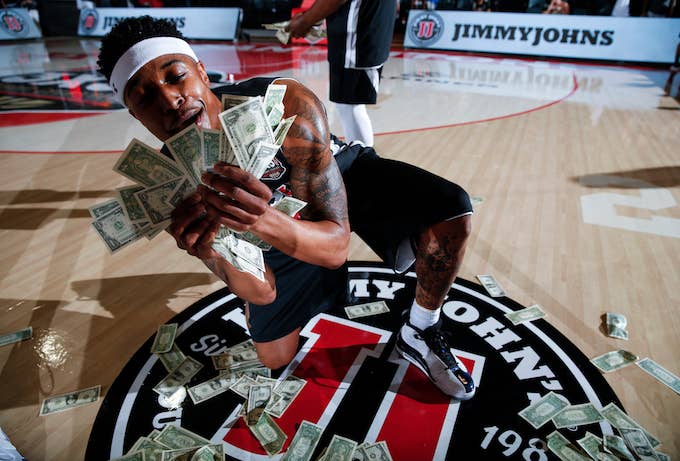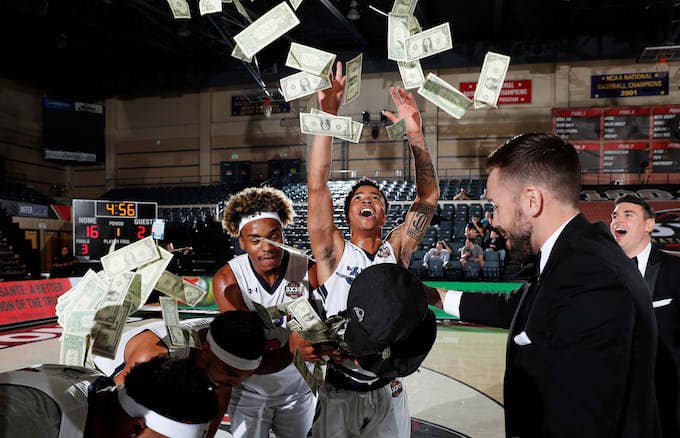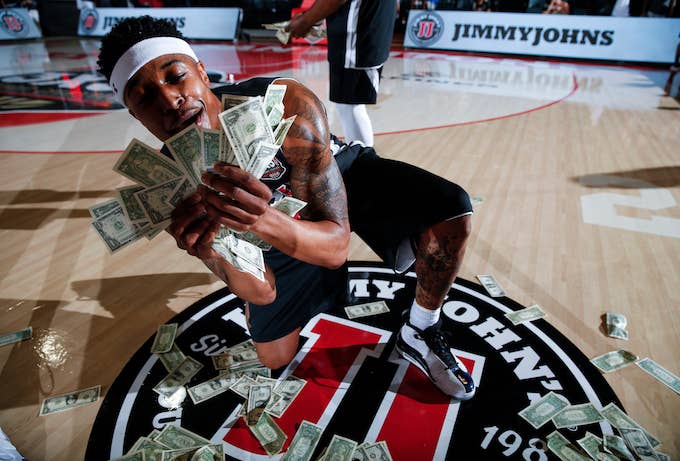
SAN ANTONIO — Moments after Jamal Aytes stepped to the line and calmly sank two free throws, leading his Big Sky team to a 21-20 win over the SWAC, a duffel bag of cash, thrust from the sidelines, landed on the court. He’s finally cashing out.
Take a $16 Uber ride from the Alamodome and you’ll find college basketball players from all over the country celebrating their own duffel-bag moments. Well, technically, the guys balling out in this 3-on-3 tournament aren’t college athletes anymore—they’re seniors whose NCAA eligibility expired after their last collegiate game.
Here at the first annual Dos Equis 3X3U (pronounced “three-on-three-you”) National Championship at St. Mary’s University, all 32 D-1 conferences have a team in attendance. With constant music—like “Why You Always Hatin?” and “Walk It Talk It”—pumping through the venue and the athletes genuinely playing hard, the environment is electric.
“The competition is high because everybody wants to win money,” says Ates, who averaged 12.7 PPG and 5.3 RPG this season for Southern Utah. “We’re all seniors who are about to go off into the world, so we all just want that cash. It’s great.”
In this setting, it doesn’t matter whether you’re from North Carolina or North Carolina A&T. All that matters is whether you can get buckets.
In the first game of the tournament, the SWAC beat the Big 12. Later that day, the MEAC took down the ACC and Atlantic Sun conquered the Big East. This tournament presents an opportunity for smaller-conference players to show they can hang with the big dogs.
The incentive: prize money totaling $100,000. The team that wins it all will receive $50K to split. Every victory prior to the championship nets the winning team $1,000—which the tuxedoed Mark Titus and Tate Frazier of The Ringer toss from their sideline broadcasting space onto the court. The players proceed to make it rain and dance as the money floats through the air.

Three-on-three hoops is having a moment. Ice Cube’s league for former NBA players, Big3, is entering its second season and has added more big names, like Amar’e Stoudemire, Baron Davis, and Metta World Peace. Last summer, the IOC added 3-on-3 basketball to the 2020 Olympics. When that decision was announced, marketing agency Intersport, which has organized the annual college dunk contest and 3-point shootout at the Final Four for the past 30 years, saw an opportunity.
“Three-on-three has been played in college at the grassroots level for years, and we thought, ‘Wouldn’t it be awesome if we could get the elite players and do this?’” says Drew Russell, the agency’s VP of Sports Properties. “We wanted to be equitable across the 32 Division I conferences and have a team like the SWAC competing with the Big 12, and obviously the kicker was that we could throw a little money at them, too.”
Intersport is covering the players’ travel and hotel accommodations and also providing per diems.
College hoops fans have been readily familiar with some of the participants for years: Shaquille Morris (Wichita State) and Jae’Sean Tate (Ohio State), for example. Others, like Wes Clark (Buffalo), became more well-known during the NCAA Tournament.
“Just the exposure, there are a lot of big-name guys, and I felt like I could get out here and show what I’m made of,” says Clark, who was unconscious from three in the MAC’s 21-19 loss to the Big East Saturday. “The biggest aspect of it was me staying in shape and seizing another opportunity, but at the same time I do have that fire that I feel like I am as good as anybody in the country.”
Games run either 10 minutes or until one team scores 21 points. With a 12-second shot clock, they play by ones and twos, no make-it-take-it. The teams are player-coached, and there are real, NCAA-certified refs overseeing every matchup—you can’t have any of that “call your own fouls” business when there’s real money on the line.

Every college senior not playing in the Final Four was eligible to participate. The 18-person player-selection committee consisted of college hoops journalists from a wide range of traditional (ESPN) and non-traditional (Barstool Sports) media outlets. Not every player who received an invitation said yes, but many did.
“We spent the past three weeks banging the phones, talking to athletic directors, conference commissioners, players, parents, coaches, and bringing them in,” Russell says. “What I’m excited about is, we’ve got 124 players here that wanted to be here. Nobody pressured them into it. They wanted to be pioneers on this event, and I think it shows because the competition’s been incredible.”
Intersport brought in the USA World Cup three-on-three team—Damon Huffman, Craig Moore, and Daniel Mavaraides—to practice with each squad for 90 minutes Thursday, teaching them how to play in this different format.
“It’s more isolation-based,” Aytes says of 3-on-3. “You’ve got to be a really effective scorer to get it done here. You can’t let yourself be a mismatch…you’ve got to be the total package to compete here.”
Friday and Saturday’s early-rounds 3X3U action, which featured two games at a time, has streamed on Twitter. The tournament is posting regular updates there as well.
You can catch the quarterfinals on Twitter Sunday from 2-3 p.m. EST. The semifinals, third-place game, and championship will air on ESPN2 from 3:30-5:30 p.m. Sunday.
There’s no question those in this tournament would rather be playing at the Alamodome this weekend, but 3X3U presents a nice consolation prize—and a valuable addition to one of the greatest spectacles in American sports. The players in attendance for the inaugural event say they expect even more seniors will want to participate next year.
“I think so, for sure,” Aytes says. “There’s great competition. You’ve got all the conferences, $100,000 on the line, you’re at the Final Four, it’s really a big deal. I don’t see why you wouldn’t, as a competitor.”

